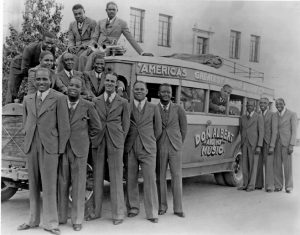Outside the bright lights of Harlem, where Ellington and Armstrong reigned supreme, hard-working, lesser-known orchestras brought jazz to the masses. Like the barnstormer leagues of baseball, these “territory bands” of hungry newcomers played small-town dance halls, ice cream socials, and Elks Lodges, and introduced rural America to its native music. 
Based in smaller cities and touring a general geographic region, these territory bands played most every night. Young musicians saw them as training to break onto the national scene. Count Basie and Lester Young, for example, got their starts in Walter Page’s Blue Devils, touring a circuit from the upper Midwest to Oklahoma City.
Heartland circuits were fertile ground for the primarily all-Black territory bands. But they were not without pitfalls. Small-town Midwest, especially, fell under the withering gaze of Jim Crow. Segregation and intimidation were commonplace. Lynchings were not unheard of. Bands were careful not to book gigs in “sundown towns.”
Despite the dangers, as Village Voice jazz critic Francis Davis wrote, “Territory bands disseminated swing and jazz to an ignored audience where radios and record players were still rare.” Culturally, territory bands were often an audience’s first encounter with the Black community. Black musicians took the stage in the face of prejudice, but in so doing, opened ears to the art of Jazz and, through that art, opened minds against preconceived notions.
“Soundtrack to the Struggle” is hosted by Hollis Monroe. Produced by Ron Adkins. Executive Producer is Dennis Green.
Podcast (soundtrack): Play in new window | Download
Subscribe: Apple Podcasts | RSS


